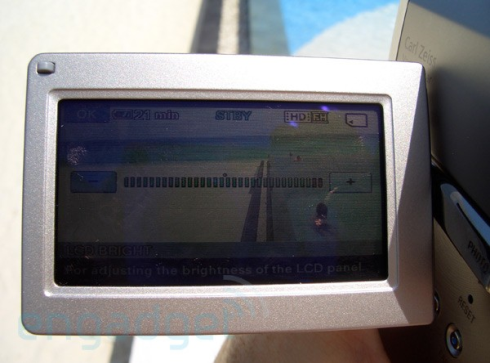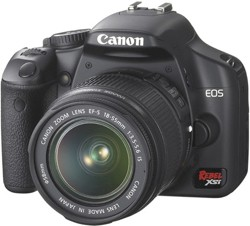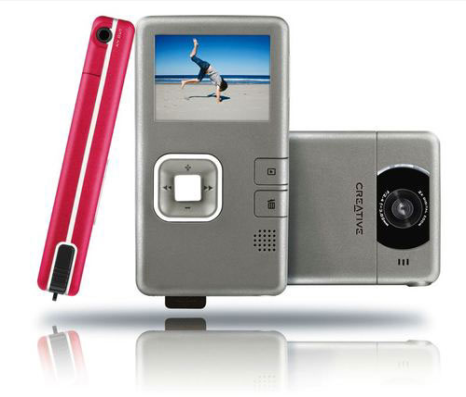
We had the good fortune to receive a Sony
HDR-TG3E (aka,
HDR-TG1 for North America) review unit on the day we departed for a bit of tropical relaxation. As such, we return with a real world look at how the Titanium-shelled TG3E performed in the sun, surf, and sand of an honest to goodness family holiday. We set off with high hopes for the world's smallest 1080i (1920 x 1080/60i @ 16Mbps) camcorder, high enough that we left our trusty
Xacti HD700 at home. Not high enough to leave behind our aging, but proven 5 megapixel point-and-shoot still camera though. So, how did it do? Review after the break.
Update: Added .m2ts video sample
for download.
Touchscreen User InterfaceWhile people tend to love or hate touch-screens, we generally consider ourselves lovers, not haters of the once novelty display technology. We're willing to sacrifice those deliciously tactile buttons to the gods of gadgetry in exchange for a more compact device with bigger screen and cleaner overall design. That love affair ends with the TG3E. The touchscreen offers no value-add to the consumer here, only distraction. Oh, where to begin...

For starters, the protruding bezel surrounding the glass combined with tiny, touch-screen target icons placed in the corners and along the extreme edges of the display resulted in our only source of grief during an otherwise blissful week adrift in the Indian ocean. As such, many of our average-size, man-sausaged attempts to tap an icon resulted in second and third pokes of increasing force. And we do mean pokes -- we found ourselves more often than not having to master our tentative, touchscreen-tapping nature and take a deliberate stab at the display to elicit a response. The incessant grubbing was further intensified by Sony's inefficient and overwrought UI.
Intuitive, the TG3E is not. We're ashamed to say that we were forced to reference the user manual for the most mundane tasks more than once during our two weeks of continuous use. Some options, such as setting the date and time, are so deeply or obtusely buried within the menus that we were left with no choice but to spin-up the CD and search the PDF. This ain't no VCR, regularly adjusting the time is an important task on a camcorder if you want your images and videos cataloged as you move around time zones -- especially if you are carrying multiple imaging devices (which we were).
We did manage to figure out most of the features by the 2nd or 3rd day of heavy usage -- an eternity given the breadth of devices we've used over the years. And seriously Sony, a minimum of seven taps just to delete a picture or video when we're limited to just 25 minutes of 1080i video on the included 4GB Memory Stick Pro Duo card? There are two methods for deleting content. The first requires 7 taps and is useful when deleting the photograph or video you just took, which, let's face it, happens all the time in the age of digital imaging: Play -> [touch photo/video to delete] -> Others -> trash can -> delete -> yes -> Ok. Another method requires 8 taps: Home -> Others -> Delete -> Delete -> Delete -> [touch photo/video to delete] -> Ok -> Yes -> Ok. The latter does, at least, allow you to select multiple, non-sequential shots for deletion all at once. Nevertheless, we can review and delete an image on our Casio Exilim compact camera and images or video on our Xacti HD700 camcorder in only 3 clicks.
Another complaint is that the touch-screen UI approach requires two hands to operate -- the right hand holds the pistol grip while the left punches away at the display. The result is an overly cumbersome system which more than once caused us to miss the early action we would have caught with our Xacti -- a camcorder which opts for a slimmed down UI and joystick for nimble, one-handed navigation. Let's be clear though, this two-handed criticism is leveled at all touchscreen camcorders, not just the TG3E.
Maybe it's just us, be we rarely do any video editing or slideshow viewing directly from the camera -- built-in HDMI jack or not. Our approach is to shoot video and photographs, dump them to disk, and then process them using a more powerful computer with a large desktop display. Regardless, Sony stuffed the TG3E with a bevy of organizational features like face, date, and roll indexing and a playlist manager. All of which allow you to (in theory anyway) quickly search and pinpoint specific moments you've captured for playback. A bit overzealous since the solid state TG3E can't exactly hold hours of 1080i video. As such, all these playback "features" come across as a lot of unnecessary fluff at the cost of simplicity and usability.
Naturally, the UI isn't everything. In fact, you'll likely begrudgingly master its idiosyncrasies just as we did. Hell, we all learned to use XP didn't we? In fact, many of us now refuse to give it up even though a prettier, sexier sibling has hit the streets. The true test of this 1080i camcorder is in the image quality. We'll get to that in a sec.
Let's shoot some video
What can we say, the TG3E is small, the world's smallest 1080i camcorder. As such, it's as portable as you'll get. While we wouldn't say it was comfortable snaking about in the front pocket of our obligatory white-linen, resort trousers, it is pocketable without causing too much of an excited SpongeBob bulge. Unfortunately, the short battery life and minimal out-of-the-box storage meant regular trips to the power jack and USB cable to recharge the battery and free up space.

Sony says that the included InfoLITHIUM battery pack NP-FH50 should provide about 45 minutes of typical battery power with the LCD on. Let's face it, without an optical viewfinder, that's pretty much your only option. In our testing, we averaged about an hour of photography and video per charging cycle. In general, battery life was never an issue. We did come dangerously close to running out of battery life on the first sunny day to hit our shores by cranking up the LCD to near 100% brightness while bumping the backlight to "bright." Big mistake. Battery life plummeted, nearly running out of juice after just a few minutes of video and a dozen or so snaps. No worries, we noticed the drain and dropped the 2.7-inch LCD back to the lower, battery friendly settings. The image was still viewable as long as we maintained a right-angle viewing position with the display. Overall, the LCD visibility exceeded our expectations even under a clear blue sky at a mere 6-degree latitude north of the equator.
Memory is of course expandable: Sony says that an ($80) 8GB Memory Stick PRO Duo will snag 55 minutes of AVCHD 1920 x 1080/60i video (highest quality) while a ($220) 16GB card pushes capacity to almost 2 hours of continuous 1080i recording. Of course, Sony offers lower quality recording options including an AVCHD 1440 x 1080/60i mode and SD, MPEG2 mode for up to 85 minutes or 2.5 hours of video on that same 4GB card, respectively.
While 25 minutes or so of 1080i AVCHD recordings on the included 4GB Memory Stick Pro Duo card doesn't sound like much, that capacity can easily last for a few days of holiday video. However, we're intensely frugal with the footage we capture, rarely allowing any given recording to exceed 1 minute in length. Still, for a one week holiday, 4GB just wasn't enough total capacity, especially since we were snapping photos with the TG3E on top of all that HD video. Our parental paranoia of missing that perfect moment meant we were routinely purging unwanted footage (7 steps each time!) and then dumping the Memory Stick content to our laptop every day or two -- yes we brought our laptop, good thing too.
Time to edit
Moving images between our Intel-based MacBook Pro running OS X Leopard and the TG3E was a snap. Just tether the TG3E via Sony's proprietary "USB Terminal Adapter" cable and select "USB Connect" when it appears on the camcorder's display. At that point, iMovie and/or iPhoto launches automatically depending upon your configuration. However, the experience was far from flawless. To be fair, most of the problems are related to AVCHD in general and thus Sony and Panasonic share equal blame.
It's worth highlighting the fact that Apple's iMovie 08 only supports AVCHD on Intel-based Macs. Older PowerPC machines need not apply.
The first minor issue we encountered was disk capacity related. See, about an hour of 1080i AVCHD video transfered via iMovie 08 equates to about 40GB of disk according to Apple. As such, we quickly found ourselves deleting files like mad in order to free-up space on our suddenly itty bitty laptop hard drive. Unfortunately for the kids, their Disney flicks were the first thing to go. Once the imports started, they were verrrry slow. Import times were on an order of 3x longer than the length of the footage shot. As such, 20 minutes of video could easily take an hour or longer to transfer. Why? iMovie 08 does not support AVCHD directly, it converts the video to the Apple Intermediate Codec on the fly during import. Ugh, we must have missed that in Apple's fine print.
After getting the videos transfered, we discovered that iPhoto and iMovie were unable to automatically delete the images or video from the camcorder. Instead, we had to finger our way through the TG3E's deletion maze and choose "Delete All" under both the video and image deletion menu options. Fine given our constant shoot and dump-to-laptop approach. But this would have created havoc if we had been selecting individual files to transfer off the camcorder.
Our next unpleasant surprise was audio related. We're unable to export movies created within iMovie 08 at a full 1920 x 1080 resolution with the original Dolby Digital 5.1 channel sound in tact. A real disappointment. This appears to be a limitation overcome by Final Cut Pro which, unfortunately, we don't have. iMovie strips the audio down to two channel stereo during the import process. Double ugh!
Unfortunately, it doesn't get any better when using the Sony supplied Picture Motion Browser v3.0 software (with relevant plug-ins) on our PC. While videos transfered very fast to the native AVCHD Windows-only software, we were unable to playback the imported .mt2s videos in the supplied AVCHD player. The latest official release (and even the latest nightly build) of VLC choked too. After a few hours of trying, we gave up. Regardless, the software was so tedious and coated in such a thick layer of Sony-coded drudgery that there was nothing we felt worthy of salvage. PC users will be going to third parties like Cyberlink, Corel, Nero, and others if they buy this camera.
Video and image quality
This is what it all boils down to right, the quality of the image, still or moving. At this point we could sit back and tell you that the 4 megapixel still images weren't as sharp as we'd like or that the colors tended to be over saturated. We could also comment on the camera's decent pickup (without pixelation) of fast action scenes under well-lit environments and how well the TG3E's electronic image stabilization seemed to handle shake under the camcorder's max, 10x zoom. We could even lament the heavy grain experienced under typical, in-home lighting. Instead, we'll just post a few examples for your own highly subjective grandstanding.
139MB: 1080i zen recorded outside under mid-day, equatorial sunshine
157MB: 1080i grain-fest shot indoors, late afternoon sunshine, near large French doors
219MB: 1080i shot outside under decidedly weaker, northern European sun at full 10x optical zoom
17.7MB: Exact same scene shot at 720p with Xacti HD700 at full 5x zoom (note wind noise, relatively shaky picture, and size of that file)
134MB: SMTH SLW REC slow motion mode -- we're suckers for slo-mo even if it's at the cost of image quality and limited to just 3 seconds of footage
70MB: 1440 x 1080 dancing robot in .m2ts format
We think the image gallery comparing identical scenes shot with the TG3E and four year old, 5 megapixel Casio Exilim EX-Z55 speaks for itself.
Other things we disliked... and liked
What, no headphone or microphone jacks Sony? Did you not notice these on the Sanyo Xacti HD1000 during your competitive analysis?
There's a long list of niceties include the look (sex in a box), the weight (light but not cheap), automatic lens cap, 3-second SMTH SLW REC slow motion recording, snappy image-stabilized 10x optical zoom, and HDMI jack right on the camera. We also like the Quick On mode which puts the camera to sleep for up to 15 minutes after you close the LCD. That means you can start recording in as little as 2 seconds vs. 5 seconds when the camcorder is turned completely off.
Bottom line
Overall, the TG3E is a winner of a product as long as you're setup to deal with the AVCHD file format. In other words, you should factor in the cost ($100 and up) of a proper AVCHD video editing software package with the purchase of the TG3E. For some of you, those who value ultra-portable convenience over the quality you get by carrying multiple devices, the TG3E could even replace your point-and-shoot camera on holiday. Not us though.
As much as we expected to, we simply can't give the TG3E an enthusiastic Engadget recommendation for one simple reason: Sanyo's XACTI HD1000. We used the HD1000 extensively at CES and it's nearly spec-for-spec identical to the TG3E. It also features a much simpler UI requiring only a single hand to operate, an external mic jack, and video recordings in the much more popular MPEG-4 AVC/H.264 format for $250 less than the TG3E. Guess what our choice would be?
[Via:
Engadget ]
[Tag: camcorder,features,review,sony,tg1,tg3e ]














































